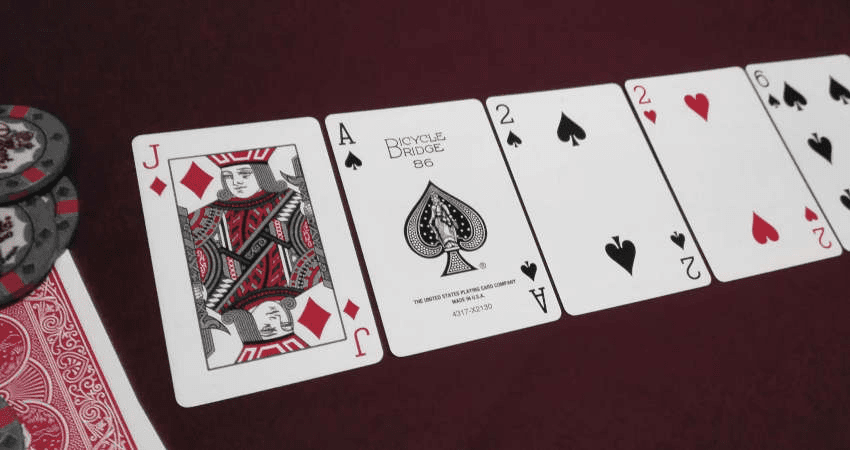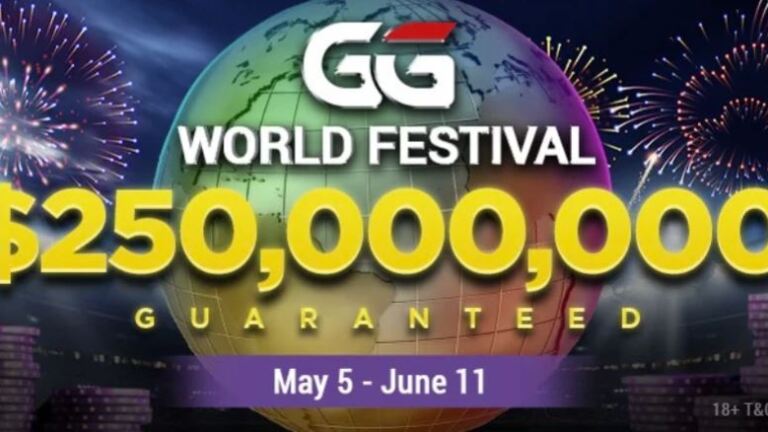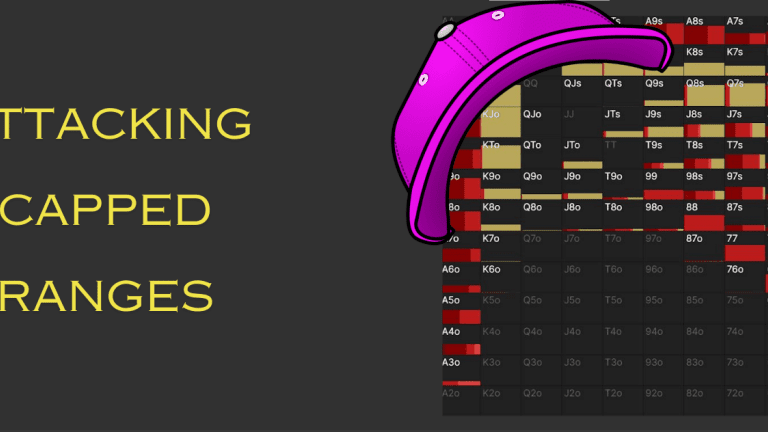Last time we saw the three barrel situation, now we jump into the plays after the delayed c-bet, the bet-check-bet line and a less common but still crucial check-check-bet line.

River play after delayed c-bet
As we have seen, there are two main scenarios: you range check certain flops that heavily benefit the Big Blind player and then delay c-bet on turns, or you check part of your range on the flop as the texture is more balanced regarding who has the advantage. Therefore, you need to protect your checking range, and naturally, you'll also have strong hands in your delay c-bet branch.
Let's examine some of these with examples. Both of you checked the  8
8  6
6  4 flop. The turn is
4 flop. The turn is  K you delay c-bet 2/3 pot, and the river is a total brick, the
K you delay c-bet 2/3 pot, and the river is a total brick, the  J . You must realize this is a very favorable spot for you as the Small Blind. You had a wide variety of valuebets on the turn, as weak as A8o, which means your value range is pretty wide. In the meantime, some of your bluffs picked up a pair, like
J . You must realize this is a very favorable spot for you as the Small Blind. You had a wide variety of valuebets on the turn, as weak as A8o, which means your value range is pretty wide. In the meantime, some of your bluffs picked up a pair, like  J
J  T ,
T ,  J
J  7 , etc. This results in that you can value bet on the river with almost your entire range. Fundamentally, some weak 8x and A-highs are not incentivized to bet here, nor are some of the worst blocker hands like
7 , etc. This results in that you can value bet on the river with almost your entire range. Fundamentally, some weak 8x and A-highs are not incentivized to bet here, nor are some of the worst blocker hands like  T
T  7 .
7 .
How about a more complicated runout? The turn play was the same, but the river brings the  7 . Your valuebets on the turn coincides with the example above, but the river card' ruined' some of these hands' chances. Moreover, hands like two-pairs, sets or even a straight with a 5 look less exciting now with possible flushes and higher straights in Villain's range. Usually, when something terrible like this happens to your range, but you still have strong hands to valuebet with, you must size down. At the same time, you have to check some super strong hands to protect your checking range, such as
7 . Your valuebets on the turn coincides with the example above, but the river card' ruined' some of these hands' chances. Moreover, hands like two-pairs, sets or even a straight with a 5 look less exciting now with possible flushes and higher straights in Villain's range. Usually, when something terrible like this happens to your range, but you still have strong hands to valuebet with, you must size down. At the same time, you have to check some super strong hands to protect your checking range, such as  A
A  K , which blocks most of the calling range (and possible bluffing hands) and has good properties to go for more considerable value. It is important to note that against weak-passive opponents, this latter part is moderately accurate. Actually, you could lose EV in some cases if you misread your opponent.
K , which blocks most of the calling range (and possible bluffing hands) and has good properties to go for more considerable value. It is important to note that against weak-passive opponents, this latter part is moderately accurate. Actually, you could lose EV in some cases if you misread your opponent.
Let's see a more complex example: you delay c-bet on  T
T  3
3  9
9  5 . You might consider even overbetting; the point is that you'll have a polarized range here. It would be a polarization error to bet something like 98s or A5s, and you shouldn't include many 0 EQ bluffs when you have a vast number of them (unless you have data or evidence that your opponent is defending poorly against delayed c-bets). With this intro, you reach the river. If it's a brick, you probably figured it out; nothing has changed, and your turn value bets look good to bet again. Moreover, an AT, KT+, is strong enough to overbet again. If the river is the
5 . You might consider even overbetting; the point is that you'll have a polarized range here. It would be a polarization error to bet something like 98s or A5s, and you shouldn't include many 0 EQ bluffs when you have a vast number of them (unless you have data or evidence that your opponent is defending poorly against delayed c-bets). With this intro, you reach the river. If it's a brick, you probably figured it out; nothing has changed, and your turn value bets look good to bet again. Moreover, an AT, KT+, is strong enough to overbet again. If the river is the  3 , how to choose the best bluffs? Well, you might want to avoid missed flush draws or hands that block folds, but not many calls. For instance, you have missed straight draws like QJo and 87s. The argument here is that 87s have close to zero showdown value but might fold out a hand like an ace-high flush draw or a higher (also missed) straight draw, which, to you, would lose anyways. At the same time, QJo has a bit more showdown value (don't get me wrong, also not much), but its characteristics are horrible, blocking a variety of draws you wish to fold out while not blocking much of the calling range.
3 , how to choose the best bluffs? Well, you might want to avoid missed flush draws or hands that block folds, but not many calls. For instance, you have missed straight draws like QJo and 87s. The argument here is that 87s have close to zero showdown value but might fold out a hand like an ace-high flush draw or a higher (also missed) straight draw, which, to you, would lose anyways. At the same time, QJo has a bit more showdown value (don't get me wrong, also not much), but its characteristics are horrible, blocking a variety of draws you wish to fold out while not blocking much of the calling range.
Hopefully, you get the essence of the thought process on the river and how to approach different river cards after your delayed c-bet.
Bet-Check-Bet line
Before jumping into the bet-check-bet line, I recommend you recheck the second barrel topic to understand better how we reach the river.
When you have a strong value hand, either checked on the turn planning to check-raise or made a firm hand by the river, you have very few reasons to check again. Your opponent's turn checkback indicates a mediocre hand, a one-pair type hand, ace-high or a hand with bad bluffing characteristics. You cannot expect a lot of bluffs, nor a lot of thin value bets from this range and when you think about small/low stakes players, even less. Therefore, your strong hands almost always should bet for value.
The middle part of your range, like the 2nd and 3rd pairs, weak pocket pairs are not incentivized to bet. They have way too much showdown value to turn them into a bluff (especially this many bluffing candidates), and they will lose against most of the calling range, so it doesn't work to thin-value them either.
A more interesting question is what to do when you have air hands. Even if you c-bet somewhat polarized on the flop, there will be many missed draws: gutshots, open-ended straight draws, flush draws, backdoor flush draws, ace-highs, etc. How do you choose your best candidates based purely on the theoretical perspective? First, you need to establish how many value combos you have and what sizing fits most to the situation. We've discussed the topic of bluff-value ratio in the previous article.
The river card can change a lot, bringing a lot of overcards that your opponent might not possess. For instance, you bet 2/3 on  9
9  8
8  2 , and the turn goes check-check. On a river
2 , and the turn goes check-check. On a river  K , how many top pairs will they have? On the contrary, you'll have plenty. So, naturally, you can put more pressure compared to a spot where nothing has changed or the river card doesn't specifically help any of you.
K , how many top pairs will they have? On the contrary, you'll have plenty. So, naturally, you can put more pressure compared to a spot where nothing has changed or the river card doesn't specifically help any of you.
We'll repeat some of the key factors on how to choose your best bluffs. The higher your cards, the less you want to bluff. For example, an ace-high always has some showdown value and usually blocks folds from your opponent's floating range. This is something you should avoid when ranges are wide. Your missed draws have similar characteristics: blocking the folding range while not helping against Villain's calling range. There are always in-between hands, kind of indifferent to bluff them or not.
Your job is calculating how your opponent will react and how far you can push them. For instance, if you have evidence that they called a hand you think they were supposed to fold, you can conclude to bluff less often and valuebet more thinly. On the contrary, when you see them laying down the hands they are supposed to call with, you can push them around with your bluffs.
Check-check-bet line
Last, let's talk about spots checked down to the river. These are usually on low-connected boards, where you check a lot (or your entire range) on the flop, and the turn card is also not the most exciting to start betting.
What can we conclude about this spot? Both players have their entire preflop ranges, usually 40%+ from both sides. None of the players felt incentivized to bet neither flop nor turn, so they had terrible air hands to bluff with or a weak showdown hand that could be a high card, a weak top pair, or any other pair.
Given these wide ranges, It might get tricky to valuebet and bluff. Still, it would help if you established basic principles. Those pots you can pick up with your bluffs (6 big blinds each) and those valuebets earning you 2-4 big blinds more will significantly add to your win rate, even if it feels little.
So, what hands should you include in your river betting range? Let's start with value hands; the answer always depends on the circumstances. When you hit new top pairs, two pairs with the river card, it seems natural to bet them. The smaller you bet, the wider your valuebets might be. For instance, even a third pair could be worth a 1/3 size bet. If you go like ¾, it is probably just top or 2nd pairs. It depends on how much the board has changed with the river card and how likely your opponent is ready to pay to get to the showdown.
When you have air hands, the same principles apply as always. First and foremost, how much SD value do you have? Second, what do you expect from your opponent? Commonly, weak players snap checkback hands without connection to the board, indicating that neither bluffing nor calling crossed their minds. You should definitely attack these players in these spots. Also, their previous showdowns or statistics like aggression and went to showdown can give you a hint.
There is probably no one-fit-all answer to how to play these river spots, but the more you practice, the better your idea of how the pool reacts.
Takeaway
In part II. we went through the following spots: river play after delayed c-bet, bet-check-bet line and the check-check-bet line. As you can see, a lot depends on understanding the ranges arriving at the river in each situation. It would be best to recognize how river cards affect these ranges and play accordingly. When you have enough practice in this spot, you might deviate to exploit your weaker opponents. Remember that a theoretically perfect approach might be misleading when the majority of the player pool plays weakly or passively. Also, it is expected to see that checking ranges are not protected, which leads to unbalances in Villain's holding arriving at the river. Most players will lack strong holdings, which you should also adjust.
Hopefully, these topics helped you to understand better the river, and you can take advantage of your opponents. Good luck at the tables!





















